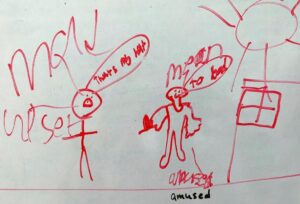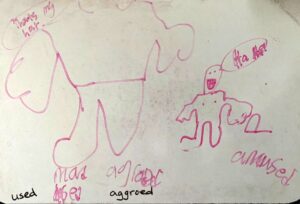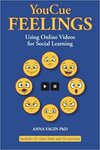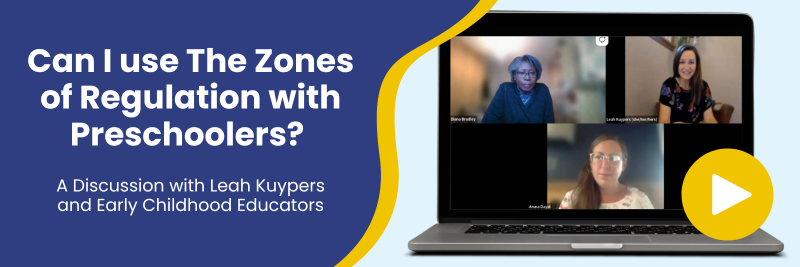
Anna Vagin, PhD, is a licensed Speech and Language Pathologists who provides individual sessions and social learning groups to children, young adults, and their families in her private practice in Marin County, California.
Three middle school students have arrived for their session. In the past, we’ve talked about how they feel that other students harass and annoy them, in part because they all have big reactions. They are familiar with The Zones of Regulation and know what tools are the most helpful to themselves. We have expanded their understanding of feelings using activities in YouCue Feelings. But still, in the moment, their “buttons” get pushed, and they struggle to regulate within those feelings of annoyance and anger. We have worked through many of The Zones lessons, including understanding different perspectives and triggers. While they understand how their reactions make them easy targets, they haven’t yet developed the regulation skills that can help them in the moment. That’s our focus in the session –they all agree they want to turn these big reactions and feelings into smaller, more manageable ones that don’t draw attention.
In previous sessions, we have considered what we never want to change about ourselves, as well as what we might consider changing about ourselves. Phrases like “I’m tired of blowing up with all the kids watching” and “I want to learn how to be more chill during recess” reflect their readiness to explore changing and evolving in the way they handle uncomfortable situations. To begin our work, rather than focusing right away on their experiences, we are starting with a terrific animated video: “Maca and Roni: Snowball Fight“.
I love using carefully selected animated videos as engaging social learning material. Feelings, and the intricacies of social relationships are complicated and abstract. When you combine that with the fleeting nature of human interaction, there’s a lot to process, prioritize, and track.
Animated videos provide opportunities to:
- Watch and re-watch important moments, even slow the pace for accessibility
- Break down feelings, intentions, and reactions
- Discuss, understand, and start making connections to themselves
Maca is peacefully building a snowman, when a snowball hits him in the head. Another one knocks the head off his snowman! In just a few seconds, he goes from feeling happy and proud to feeling sad and very annoyed. It’s his lab partner Roni having a little snowy day fun. A great example of different perspectives and feelings. As his angry feelings build, Maca decides to take revenge. Oh, and all this happens in less than a minute.
Just like Maca, we all get angry in The Red Zone sometimes, and sometimes we all have big reactions. Managing our feelings begins with recognizing and understanding them. Part of this is realizing that they are part of our shared human experience – that we are not alone in our feelings. What helps us develop this understanding? Having a broad emotional vocabulary, understanding that feelings come in sizes and combinations, and recognizing that feelings can change quickly (like Maca when he was hit by that snowball), all help us take care of our feelings, and ultimately, our lives. Watching appealing characters can support this learning.
The students love the video, and we have a lively discussion. How big was Maca’s angry feeling? Why did Roni act the way he did, and what feelings might have been behind his actions? Was Maca justified in how he reacted? Did he have other options? What might happen next? We all agree that Maca had a BIG reaction. One of the students interjects “Something like that actually happened to me today.” A great connection has been made! As we transition to self-reflection, I ask students to illustrate a time when they had a big reaction, similar to Maca’s. They all get to work with 2 dry erase boards each to tell their story. Here’s one set of sketches:


I encourage all of my students to sketch, no matter their age, developmental level, or fine motor skills. Sketching makes events more concrete, and allows the fleeting nature of interaction to freeze. That allows our students to think, add relevant details, and create a visual support that makes all that social understanding easier – what different characters were thinking and feeling, what their intentions were, the sizes of feelings, possible choices, and more. And sketches tell us what students understand.
In the above sketches, there are talk bubbles, as well as feeling labels for each of the participants. Notice the size of the student in the second sketch – it clearly reflects how BIG his reaction was. He’s also added some very interesting feeling labels. Used, mad, and aggroed (I was informed that it’s the “cool” word for aggravated,) as well as amused for the student who took his hat. The other students in the group drew similar experiences. Our discussions didn’t focus on “Oh – you were in The Yellow Zone – how could you have gotten back to The Green Zone?” That isn’t the point with emotional learning or The Zones of Regulation. It’s more important to recognize and understand what feeling angry is all about; to consider feeling size and problem size; to talk about how “angry happens” and that it’s not our fault that we feel angry – it’s part of the wide spectrum of emotions we all experience.
As our discussion unfolds, one of the students interjects “I just wish I didn’t have those big reactions – then I think X would leave me alone – he likes to see me upset.” I see head nods, and realize this is something they all would like. Now, after we’ve discussed anger in greater depth, our focus has shifted direction, to managing this common feeling. But while handling those big angry feelings on the blacktop may be super challenging, I know we can do some practicing in our session – a small step down the path of managing anger to allow these students to feel better about themselves and how they are with others.
Our deep dive into understanding Maca and Roni provided an opportunity for these students to explore and discuss the intricacies of anger and the Red Zone. As we move into practice activities, I know they have started making connections to their own feelings – the universality of emotions, and the important understanding that they are not alone in sometimes struggling with strong feelings. Taking care of ourselves and our feelings/Zones can be difficult and takes practice – and using animated videos provides a solid and engaging starting point.
Ready to integrate some animated videos into your Zones of Regulation work?
Check out these recommendations! (Remember to always preview videos in their entirety).
Happy viewing!
ANNA’S VIDEO RECOMMENDATIONS FOR ZONES!

Anna Vagin, PhD, is a licensed speech/language pathologist with over 30 years of experience. In her private practice in Marin County, California, she provides individual sessions and social learning groups to children, young adults, and their families. Her particular interests are using media and gaming, including Therapeutically-Applied Role-Playing Games, to support students with social cognition and language differences. She provides consultation to parents and schools, and is a frequent speaker, both in person and via webinar, in the US and Canada on topics related to social cognition.

Providing innovative materials to parents and clinicians working in social cognition, Anna is the author of Movie Time Social Learning (2013) and YouCue Feelings: Using Online Videos for Social Learning (2015), and the developer of the Conversation Paths Pack (2020) and The Conversation Paths Pack Expanded Version (2021.)





